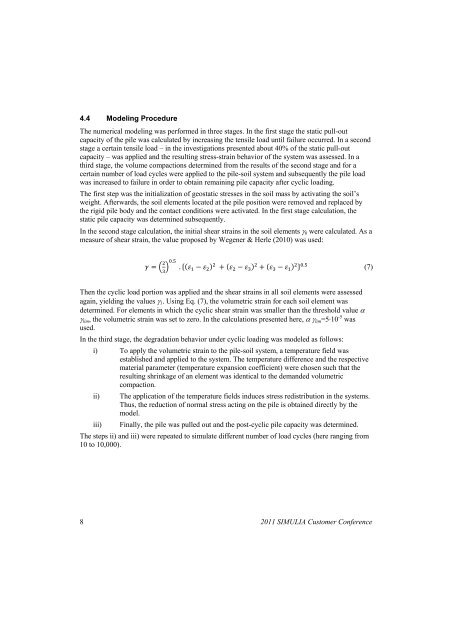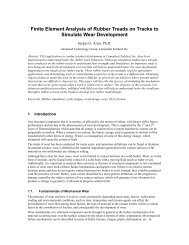Behavior of Foundation Piles for Offshore Wind Energy ... - SIMULIA
Behavior of Foundation Piles for Offshore Wind Energy ... - SIMULIA
Behavior of Foundation Piles for Offshore Wind Energy ... - SIMULIA
You also want an ePaper? Increase the reach of your titles
YUMPU automatically turns print PDFs into web optimized ePapers that Google loves.
4.4 Modeling Procedure<br />
The numerical modeling was per<strong>for</strong>med in three stages. In the first stage the static pull-out<br />
capacity <strong>of</strong> the pile was calculated by increasing the tensile load until failure occurred. In a second<br />
stage a certain tensile load – in the investigations presented about 40% <strong>of</strong> the static pull-out<br />
capacity – was applied and the resulting stress-strain behavior <strong>of</strong> the system was assessed. In a<br />
third stage, the volume compactions determined from the results <strong>of</strong> the second stage and <strong>for</strong> a<br />
certain number <strong>of</strong> load cycles were applied to the pile-soil system and subsequently the pile load<br />
was increased to failure in order to obtain remaining pile capacity after cyclic loading.<br />
The first step was the initialization <strong>of</strong> geostatic stresses in the soil mass by activating the soil’s<br />
weight. Afterwards, the soil elements located at the pile position were removed and replaced by<br />
the rigid pile body and the contact conditions were activated. In the first stage calculation, the<br />
static pile capacity was determined subsequently.<br />
In the second stage calculation, the initial shear strains in the soil elements γ0 were calculated. As a<br />
measure <strong>of</strong> shear strain, the value proposed by Wegener & Herle (2010) was used:<br />
��� �<br />
� ��.�<br />
.��� � �� � � � � �� � �� � � � � �� � �� � � � � �.� (7)<br />
Then the cyclic load portion was applied and the shear strains in all soil elements were assessed<br />
again, yielding the values γ1. Using Eq. (7), the volumetric strain <strong>for</strong> each soil element was<br />
determined. For elements in which the cyclic shear strain was smaller than the threshold value α<br />
γlim, the volumetric strain was set to zero. In the calculations presented here, α γlim=5·10 -5 was<br />
used.<br />
In the third stage, the degradation behavior under cyclic loading was modeled as follows:<br />
i) To apply the volumetric strain to the pile-soil system, a temperature field was<br />
established and applied to the system. The temperature difference and the respective<br />
material parameter (temperature expansion coefficient) were chosen such that the<br />
resulting shrinkage <strong>of</strong> an element was identical to the demanded volumetric<br />
compaction.<br />
ii) The application <strong>of</strong> the temperature fields induces stress redistribution in the systems.<br />
Thus, the reduction <strong>of</strong> normal stress acting on the pile is obtained directly by the<br />
model.<br />
iii) Finally, the pile was pulled out and the post-cyclic pile capacity was determined.<br />
The steps ii) and iii) were repeated to simulate different number <strong>of</strong> load cycles (here ranging from<br />
10 to 10,000).<br />
8 2011 <strong>SIMULIA</strong> Customer Conference



